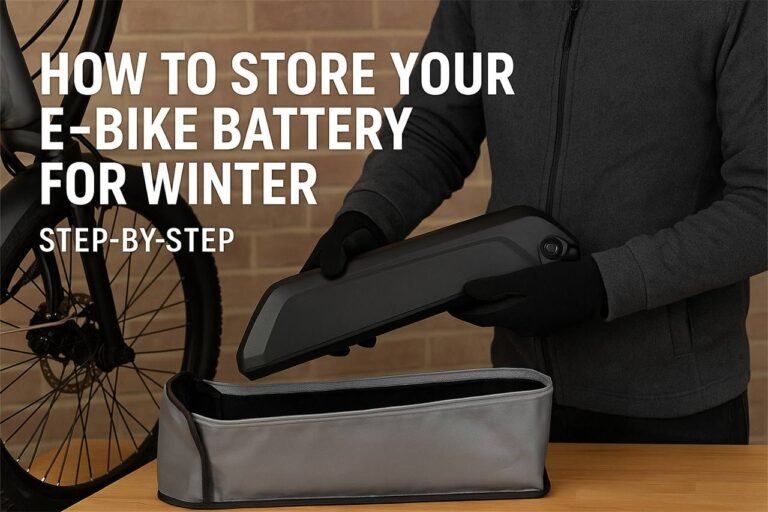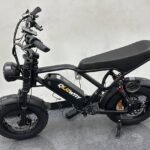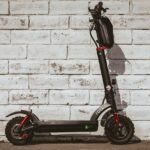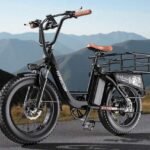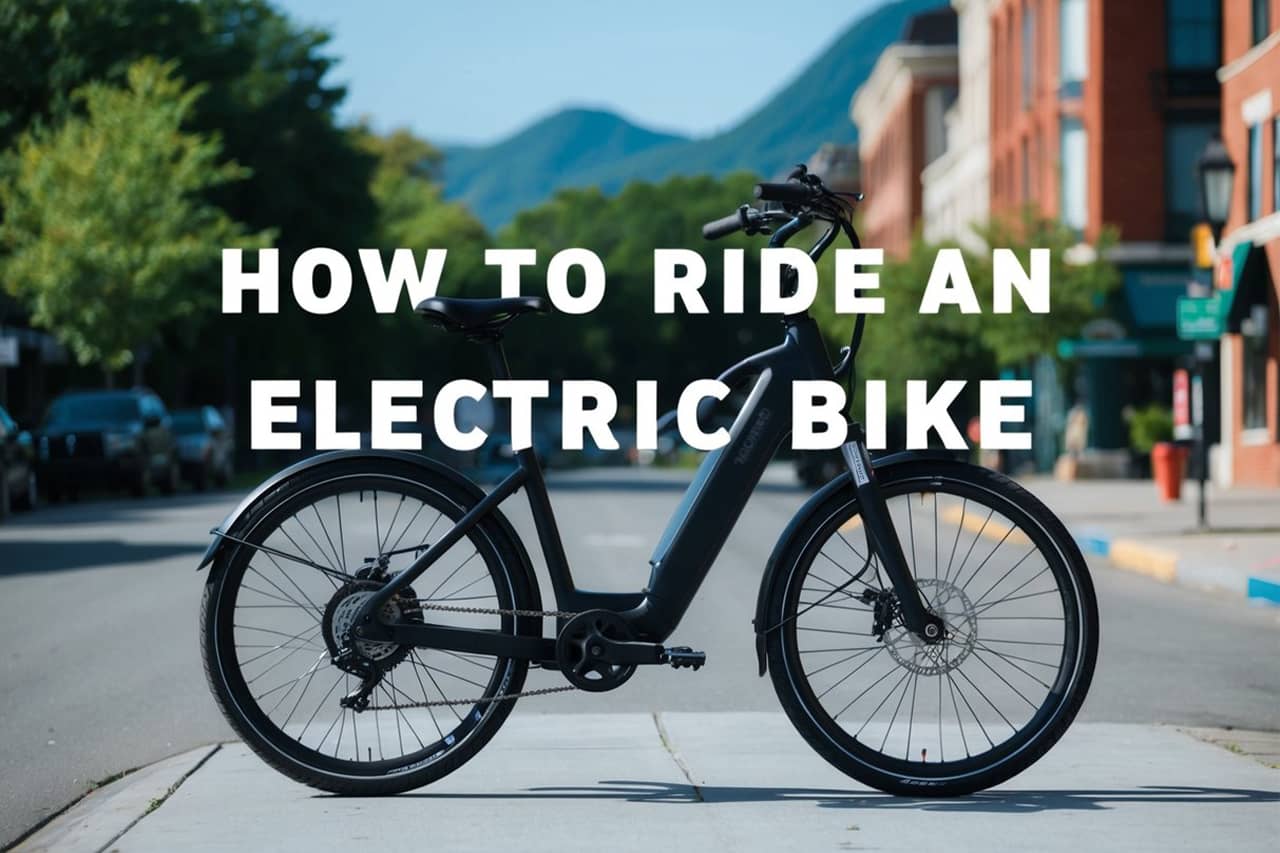
Thinking about zooming around on an electric bike but not sure where to start? I’ve got you covered with the basics to get you riding like a pro in no time.
Here’s how to ride an electric bike in five simple steps:
- Check your e-bike’s battery and tires.
- Wear a helmet and adjust the seat.
- Power on and select assist mode.
- Pedal or use the throttle gently.
- Brake smoothly and follow traffic rules.
In this guide, I’ll break down each step with all the details you need, plus toss in tips for handling different bikes and terrains. Let’s roll!
What You’re Going To Need
Before you hop on, make sure you’ve got these essentials:
- Electric Bike: Any class (1, 2, or 3) works; ensure it’s charged.
- Helmet: MIPS-equipped for extra safety, like a Bell Avenue.
- Comfortable Shoes: Flat soles for better pedal grip.
- Reflective Gear: Vests or ankle bands for visibility.
- Bike Lock: A Kryptonite U-lock for security.
- Optional: Phone mount for navigation, like a Quad Lock.
Video Tutorial
This short REI video shows the basics of starting and controlling an e-bike safely.
STEP 1: Check Your E-Bike
First things first—make sure your e-bike is ready to roll. Pop the battery out and check its charge; most displays show a percentage or bars. A full charge gives you 20-70 miles, depending on the bike, per a 2023 Electric Bike Report study. If it’s below 20%, plug it in for a bit.
Next, inspect the tires. Look at the sidewall for the recommended PSI (usually 30-50 for commuters) and use a pump with a gauge. Squeeze the brakes to ensure they’re responsive—disc brakes should stop smoothly. A quick once-over for loose bolts or a dry chain (lube it if needed) saves headaches later.
Tips:
- Charge indoors at 50-70°F to extend battery life.
- Carry a portable pump for mid-ride flats.
- If the battery’s detachable, lock it to the frame.
STEP 2: Gear Up and Adjust
Safety and comfort are non-negotiable. Strap on a helmet—a 2022 NIH study says helmets cut head injury risk by 69%. Clip it snug under your chin. Throw on a reflective vest or bands if you’re riding near traffic; they make you pop in low light.
Adjust the seat so your knees are slightly bent at the pedal’s lowest point. Most e-bikes have a quick-release lever for height tweaks. Stand over the frame—if you can’t touch the ground with both feet, lower it a smidge. Check the handlebars; they should be at hip or chest height for control.
Tips:
- Wear gloves for grip and crash protection.
- Test seat height in a parking lot before hitting the road.
- If your bike’s step-through, mounting’s a breeze—just swing a leg over.
STEP 3: Power On and Select Mode
Time to fire up the beast. Find the power button—usually on the battery or handlebar display. Hold it for a second until the screen lights up, showing speed, battery, and assist levels. Most e-bikes have 1-5 assist modes; start with 1 or 2 to ease in.
If your bike’s Class 2, you’ll have a throttle on the handlebar. Twist it lightly to test the motor—it’ll feel like a gentle push. For pedal-assist (Class 1 or 3), pedal softly to engage the motor. A Bosch Performance Line motor typically kicks in within a half-pedal stroke. Practice in a quiet area to get the hang of it.
Tips:
- Check the display for error codes; google them if you see one.
- Low assist saves battery for long rides.
- Throttle-heavy riding drains juice faster—mix in pedaling.
STEP 4: Pedal or Throttle Up
Now you’re moving! Start pedaling smoothly, and the motor will amplify your effort in assist mode. It’s like having superhuman legs—Class 1 and 2 bikes hit 20 mph, while Class 3 can reach 28 mph. If you’ve got a throttle, twist it gently for a boost without pedaling.
Shift gears like on a regular bike to match terrain. Use higher gears on flats for speed and lower ones on hills to ease motor strain. Keep your eyes up, scanning for obstacles. A 2024 Bicycling Magazine guide suggests a 70-90 RPM cadence for efficiency—pedal steadily, not frantically.
Tips:
- Practice starts and stops in a lot to build confidence.
- Lean slightly into turns to stay balanced.
- If the motor feels jerky, ease off and check settings.
STEP 5: Brake and Follow Rules
Stopping’s as important as going. Squeeze both brake levers gently—disc brakes are powerful, and locking up can skid you out. Most e-bikes cut motor power when you brake, so it’s smooth. Practice emergency stops: shift your weight back and brake hard but controlled.
Ride like a regular cyclist in traffic. Stick to bike lanes where allowed—PeopleForBikes maps state laws, as Class 3 bikes might be road-only. Signal turns with your arms, yield to pedestrians, and don’t blast through red lights. At night, use a Cygolite Metro Pro for 1,100 lumens of road-clearing light.
Tips:
- Check brake pads every few months; replace if worn.
- Use a bell to alert walkers on shared paths.
- Stay right unless passing, and call out “on your left.”
Bonus Tips for Different Terrains
City streets call for low assist to dodge stoplights and save battery. Watch for cars opening doors—ride a door’s width from parked vehicles. On hills, crank assist to 3 or 4 and shift to low gears; a Specialized Turbo Levo can climb 20% grades with ease.
Trails demand focus. Use a mountain e-bike with 2.1-inch tires for grip, per 2024 Dirt Rider tests. Drop the seat for descents and keep elbows loose. Gravel paths need a wider stance and moderate assist to avoid slipping—slow down for loose patches.
Terrain Cheat Sheet:
- City: Low assist, upright posture, high gear.
- Hills: High assist, low gear, lean forward.
- Trails: Mid-assist, loose grip, adjust seat.
- Gravel: Moderate assist, steady speed, wide stance.
Maintaining Your Ride
Keep your e-bike happy with regular care. Check tire pressure weekly—low tires sap battery life. Clean and lube the chain monthly; a dry chain loses 10% efficiency, says Bicycling Magazine. Charge the battery after rides but store it at 50% if idle for weeks.
For motor or display issues, visit a shop—DIY can void warranties. Find certified mechanics via Electric Bike Shop Directory. Annual tune-ups tighten bolts and align gears, keeping rides smooth.
Maintenance Musts:
- Tires: Weekly pressure checks, inspect for wear.
- Chain: Clean/lube monthly, check for rust.
- Battery: Charge post-ride, store at 50-70°F.
- Brakes: Test monthly, replace pads if thin.
Final Thoughts
Riding an electric bike is a blast once you nail the basics. Check your bike, gear up, power on, pedal smoothly, and brake smart—that’s all it takes to cruise confidently.
With a little practice and maintenance, you’ll be weaving through streets or tackling trails like a champ.
Grab your helmet, fire up that e-bike, and hit the road for some electrified fun!

![Learn How to Ride an EBIKE the RIGHT way... [Step by Step]](https://goebikelife.com/wp-content/cache/flying-press/898e2c40daf2a639e7f8e7627df57175.jpg)

![The 10-Step Checklist Before Buying Your First E-Bike: A Beginner’s Guide ([year]) Checklist Before Buying Your First E-Bike](https://goebikelife.com/wp-content/uploads/2025/06/Checklist-Before-Buying-Your-First-E-Bike-768x512.jpg)
